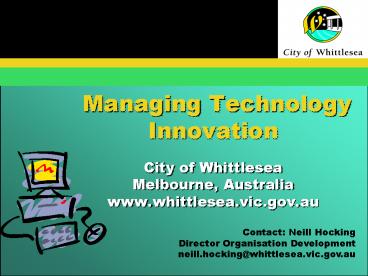Managing Technology Innovation City of Whittlesea Melbourne, Australia www'whittlesea'vic'gov'au - PowerPoint PPT Presentation
1 / 14
Title:
Managing Technology Innovation City of Whittlesea Melbourne, Australia www'whittlesea'vic'gov'au
Description:
Best of breed and integrate. Develop Civica system. Inhouse development. Development Strategy ... It has an owner who monitors the quality and reviews it regularly; ... – PowerPoint PPT presentation
Number of Views:49
Avg rating:3.0/5.0
Title: Managing Technology Innovation City of Whittlesea Melbourne, Australia www'whittlesea'vic'gov'au
1
Managing Technology InnovationCity of
WhittleseaMelbourne, Australiawww.whittlesea.vic
.gov.au
Contact Neill Hocking Director Organisation
Development neill.hocking_at_whittlesea.vic.gov.au
2
Infrastructure Business Case Not an option
but a realityGrowing community
expectationsProvision of quality services 24
7MAV, State and Federal Government taking the
lead Set up ESD capability and then develop
detailed business case for each individual
project
3
ESD
Types of Electronic Service Delivery
- Information dissemination
- Electronic Data Capture
- Online Validation
- Full end to end electronic processing
4
Multimedia Action Plan
Develop the Presentation layer so that it is web
enabled so that all the functionality of
Authority can be accessed via the web
Option 1
Authority
Presentation Function Layer Data Layer
Option 2
Develop new applications that access and
manipulate the underlying data for each area in
Authority without impacting any other layer
- Presentation Layer - Front screens for input or
display - Function Layer - Functions that manipulate either
input from the user or data for display - Data Layer - Data stored in tables in the
database
5
City of Whittlesea Web Vision
13) Translation into user friendly format 14)
Maintain privacy
Authority
User Interface
15) Capture of users profile, use and
navigation of the site
1) Highly Visual and animated 2) Simple Format
with User focus including those with
disabilities 3) Available in major languages 4)
Use of common standards and styles (style
sheet) 5) Speedy 6) Based on life events 7)
Process and Decision support 8) Uses workflow 9)
Adaptable to kiosks, IVR, etc 10) Supports full
end to end electronic processing 11) Works well
with a range of browser types and screen
resolutions 12) Flexibility
User profile
16) Preferred Language 17) Browser type 18)
Access counter 19) Other
6
Overview of Systems
Electronic Service Delivery
Mobile Computing
Community access to Information
Internal Services/Process Improvement
OUTCOMES (Benefit to community, suppliers and
internally)
- Eg
- FPN project
- Aged assessments
- Eng/Operations
- Planning enforcement's
- Eg
- Invoice processing
- Electronic workflow
- Eg
- Community Directory
- Dissemination of information
- Interim
- (Form payment)
- Full end to end processing
- Eg
- Building Permit
MEDIUM (Distribution channel)
Internet
Intranet
TOOLS (Software Hardware)
Electronic Document Management
GIS
ESD/Authority Capability Web Enabling
GPS
7
Development Strategy
- Choices
- Best of breed and integrate
- Develop Civica system
- Inhouse development
8
Development Strategy
- Actions
- Vision
- Discussion paper
- Mobilisation
- Specifications
9
Data Strategy
- Why have one?
- Move to develop electronic Council systems
- End to end electronic service delivery
- Reliance on automatic reporting
- Staff role changing from doing to monitoring
10
Data Strategy
- What is it?
- It is linked to the community plan/business
plans - It is linked to the IT plan for storage,
security, maintenance and backup - It has an owner who monitors the quality and
reviews it regularly - It is documented including relationships to
other data and business operations and - It utilises where appropriate a whole of
government approach to data standards and
metadata standards.
11
Data Strategy
- Data Requirements
- What do we need? - Primary/Secondary
- How should we get it? - Buy it/Collect it
- Who is going to look after it? -
Ownership/Maintenance - How does it fit in with everything else? -
Integration/Architecture
12
Data Strategy
- Data Specification
- Data Transparency/Visibility - Discoverability
- Data Accessibility - Who can access what, when
and how? - Data Quality Assurance - Validation/Audits/Standa
rds - Data Dissemination - How can it be used?
13
Data Strategy
- Data Management
- Data Collection Validation at input? Standards?
Ownership - Data storageCentralised/Decentralised? Security
Responsibility - Staff training
- IT BU staff
- MonitoringWho, When, How, Management
14
Key Questions
Who is responsible for systems development? How
is the new system managed? Who puts SLAs
together and manages them? Who manages the
software supplier during development? How do you
determine priorities for IT resourcing? Who
determines device management? Who chooses
architecture?































